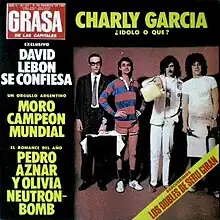| La Grasa de las Capitales | ||||
|---|---|---|---|---|
 | ||||
| Studio album by | ||||
| Released | August 1979 | |||
| Recorded | June–August 1979 | |||
| Venue | ION Studios, Buenos Aires | |||
| Genre | Progressive rock, jazz-fusion, progressive pop[1] | |||
| Length | 43:43 | |||
| Label | Sazam | |||
| Producer | Charly García | |||
| Serú Girán chronology | ||||
| ||||
La Grasa de las Capitales is the second album by the Argentine progressive rock supergroup Serú Girán, released in 1979. After its deeply criticized debut album Serú Girán, the band distanced themselves from symphonic rock and moved closer to traditional rock and pop while keeping a considerable jazz fusion element in the music, which also was present in the debut album.
The word "grasa" means "grease" in Spanish, but in Argentina it is also slang for "tacky".[2] As such, the title of the album was a criticism of the superficiality of Argentine society at the time (which was living under a military dictatorship following the 1976 coup) among other aspects what it was considered then "commercial" music (as opposed to the more elaborate lyrics and musicianship supposedly present in genres such as prog rock) with disco music being parodied in the self-titled first track.[3][4][5][6] The cover of the album is a spoof of popular gossip magazine Gente, with members of the band presented as improbable celebrities (Aznar an obscure office worker, Moro a butcher, Lebon a rugby player and Garcia a petrol station worker – a criticism to petrol companies who "stuff themselves with money and run the world" according to Garcia[7][8]) one of the headlines announcing a romance between Aznar and "Olivia Neutron-Bomb" (cf Olivia-Newton John, the star of that year's blockbuster musical "Grease").
The album spurred three hit singles. Pedro Aznar's "Paranoia y Soledad" (Paranoia and Loneliness) which was a cryptically metaphoric song talking about a man's descent into insanity; "La Grasa de Las Capitales" (The Grease/Tackiness of the Capitals) which presented a sharp criticism on the paparazzi and the frivolous magazines (as showed on the album cover) and briefly parodied disco music, and the final track, "Viernes, 3 A.M." (Friday, 3 A.M.) which had lyrics graphically depicting a man's suicide, which was banned from radio play by the dictatorship due to it "encouraging suicide". Luis Alberto Spinetta later referred to the track as "something even Lennon and McCartney would've wanted to write".[9]
In 2007, the Argentine edition of Rolling Stone ranked it 17 on its list of "The 100 Greatest Albums of National Rock".[10] In 2019, the album was remastered and reissued for its 40th anniversary.[11]
Track listing
| No. | Title | Writer(s) | Length |
|---|---|---|---|
| 1. | "La Grasa de las Capitales (The Tacky Capitals)" | Charly García | 4:37 |
| 2. | "San Francisco y el Lobo (Saint Francis and the Wolf)" | David Lebón, Charly García | 2:23 |
| 3. | "Perro Andaluz (Andalusian Dog/Un chien andalou)" | García | 4:59 |
| 4. | "Frecuencia Modulada (Frequency Modulation/FM)" | García, Lebón | 3:20 |
| 5. | "Paranoia y Soledad (Paranoia and Loneliness)" | Pedro Aznar | 6:52 |
| No. | Title | Writer(s) | Length |
|---|---|---|---|
| 1. | "Noche de Perros (Dog Night)" | Lebón, García | 6:34 |
| 2. | "Viernes, 3 A.M. (Friday, 3 A.M.)" | García | 4:18 |
| 3. | "Los Sobrevivientes (The Survivors)" | García | 3:51 |
| 4. | "Canción de Hollywood (Hollywood Song)" | García | 4:54 |
Personnel
|
Serú Girán
|
Production staff
|
Charts
| Chart | Position |
|---|---|
| 1 | |
References
- ↑ "La Grasa de las Capitales". AllMusic. Retrieved 7 October 2018.
- ↑ Conde, Oscar (2011-09-02). Diccionario etimológico del lunfardo (in Spanish). Penguin Random House Grupo Editorial Argentina. ISBN 978-987-04-1926-6.
- ↑ Govea, Salvador (2016-04-09). "¡Qué horror! ¡Eso es música comercial!". salvadorgovea.com (in Spanish). Retrieved 2022-07-15.
- ↑ Roa, José (2014-07-03). "La peste de la música comercial". HABLATUMÚSICA (in Spanish). Retrieved 2022-07-15.
- ↑ Cantilo 101.9, Radio (2019-11-04). "Análisis: "La Grasa de las Capitales", 40 años después". Radio Cantilo 101.9 (in Spanish). Retrieved 2022-07-15.
{{cite web}}: CS1 maint: numeric names: authors list (link) - ↑ "'La grasa de las capitales': las historias detrás de la obra maestra de Serú Girán grabada en plena dictadura". LA NACION (in Spanish). 2019-10-11. Retrieved 2022-07-15.
- ↑ "Página/12 :: radar". www.pagina12.com.ar (in Spanish). Retrieved 2022-07-15.
- ↑ "El día que Charly Garcia criticó a la industria petrolera (y quedó para la historia)". El sitio de la energía en la región (in Spanish). 2020-03-08. Retrieved 2022-07-15.
- ↑ "Página/12 :: radar". www.oasis.pe (in Spanish). Retrieved 2023-08-14.
- ↑ "Los 100 mejores discos del rock nacional". Rolling Stone Argentina (in Spanish). Publirevistas S. A. April 2007.
- ↑ "Página/12 :: radar". www.lanacion.com.ar (in Spanish). Retrieved 2023-08-14.
- ↑ "Los discos más vendidos de la semana". Cámara Argentina de Productores de Fonogramas y Videogramas. Archived from the original on 2020-03-16. Retrieved 2023-03-31.